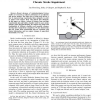Free Online Productivity Tools
i2Speak
i2Symbol
i2OCR
iTex2Img
iWeb2Print
iWeb2Shot
i2Type
iPdf2Split
iPdf2Merge
i2Bopomofo
i2Arabic
i2Style
i2Image
i2PDF
iLatex2Rtf
Sci2ools
BIBE
2008
IEEE
2008
IEEE
Feature selection and classification for assessment of chronic stroke impairment
Recent advances of robotic/mechanical devices enable us to measure a subject's performance in an objective and precise manner. The main issue of using such devices is how to represent huge experimental data compactly in order to analyze and compare them with clinical data efficiently. In this paper, we choose a subset of features from real-time experimental data and build a classifier model to assess stroke patients' upper limb functionality. We compare our model with combinations of different classifiers and ensemble schemes, showing that it outperforms competitors. We also demonstrate that our results from experimental data are consistent with clinical information, and can capture changes of upper-limb functionality over time.
BIBE 2008 | Bioinformatics | Clinical Data | Robotic/mechanical Devices | Upper Limb Functionality |
| Added | 12 Oct 2010 |
| Updated | 12 Oct 2010 |
| Type | Conference |
| Year | 2008 |
| Where | BIBE |
| Authors | Jae-Yoon Jung, Janice I. Glasgow, Stephen H. Scott |
Comments (0)

